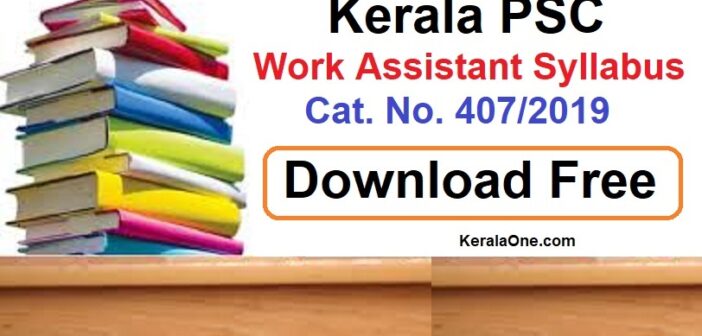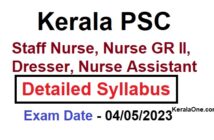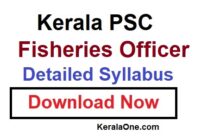Deprecated: Creation of dynamic property InsertPostAds::$settings is deprecated in /home4/keralaon/public_html/wp-content/plugins/insert-post-ads/insert-post-ads.php on line 427
Kerala PSC Detailed Syllabus for Work Assistant cat. no 407/2019
KPSC Work Assistant Detailed Syllabus:- Kerala Public Service Commission issued the examination date for the work assistant vacancies in the department of Kerala Ceramics Limited. Candidates who are preparing for the examination follow the detailed syllabus for the Work assistant post (Category Number 407/2019) published by the examination body. Here candidates can download the syllabus free in pdf format. Go through the detailed syllabus thoroughly to score high in Work Assistant Examination 2022.
Content
Work Assistant Exam Details
| Name of the Post | Work Assistant |
| Department | The Kerala Ceramics Limited |
| Category Number | 407/2019 |
| Confirmation Submitting Date |
21.12.2021 to 09.01.2022 |
| Exam Date | 03.03.2022 |
Detailed Syllabus for Work Assistant
1) Atomic structure and chemical bonding (10 marks)
Bohr’s theory, atomic spectrum of hydrogen atom, de Broglie equation, Heisenberg’s Uncertainty
Principle, Schrödinger’s wave equation, Quantum numbers and their significance, Shapes of s, p, d
and f orbitals. Pauli’s Exclusion Principle, Hund’s rule of maximum multiplicity, Aufbau’s principle,
Variation of orbital energy with atomic number, s, p, d, f block elements and their properties.
Shielding effect, Slater rules, variation of effective nuclear charge in periodic table. Ionization
enthalpy, factors affecting ionization energy, applications of ionization enthalpy. Electron gain
enthalpy, trends of electron gain enthalpy. Electronegativity, Pauling’s/ Mulliken’s and Allred
Rachow’s electronegativity scales, hybridization, Inert pair effect, relative stability of different
oxidation states, diagonal relationship and anomalous behaviour of first member of each group.
Structure, bonding, preparation, properties and uses of boric acid and borates, boron nitrides,
borohydrides (diborane), carboranes, silanes, Oxides and oxoacids of nitrogen, phosphorus and
chlorine, Peroxo acids of sulphur, interhalogen compounds, polyhalide ions, pseudohalogens and
basic properties of halogens. Occurrence and uses of noble gases, clathrates; preparation and
properties of XeF2, XeF4 and XeF6.
Radius ratio rule, Born-Haber cycle and its application, Solvation energy. Lewis structure, valence
bond theory, resonance and resonance energy, Molecular orbital theory. Molecular orbital diagrams
of diatomic and simple polyatomic molecules N2, O2, C2, B2, F2, CO, NO, and their ions; Formal
charge, Valence shell electron pair repulsion theory (VSEPR), shapes of simple molecules and ions
containing lone pairs and bond pairs of electrons, Covalent character in ionic compounds, polarizing
power and polarizability. Fajan’s rules and consequences of polarization. Ionic character in covalent
compounds: Bond moment and dipole moment. Percentage ionic character from dipole moment and
electronegativity difference. Semiconductors and insulators, defects in solids. van der Waals forces,
Hydrogen bonding and its effects on melting and boiling points, solubility and energy of
the dissolution process.
2)Coordination chemistry, metallurgy and bioinorganic chemistry (10 marks)
Werner’s theory, IUPAC nomenclature of coordination compounds, isomerism in coordination
compounds. Stereochemistry of complexes with 4 and 6 coordination numbers. Chelate effect,
valence bond theory (inner and outer orbital complexes), back bonding. Crystal field theory, CFSE in
weak and strong fields, pairing energies, factors affecting the magnitude of 10 Dq (Δo, Δt).
Octahedral vs. tetrahedral coordination, tetragonal distortions from octahedral geometry Jahn-Teller
theorem, square planar geometry. The qualitative aspect of Ligand field and MO Theory. Substitution
reactions in square planar complexes, Trans- effect, mechanism of nucleophilic substitution in
square planar complexes, Thermodynamic and Kinetic stability, Kinetics of octahedral
substitution, Ligand field effects and reaction rates, Mechanism of substitution in octahedral
complexes.
Chief modes of occurrence of metals, electrolytic Reduction, hydrometallurgy, methods of
purification of metals: Electrolytic, Kroll process, van Arkel and Mond’s process, Zone refining.
Metal ions present in biological systems, classification of elements according to their action in
a biological system. Sodium / K-pump, carbonic anhydrase and carboxypeptidase. Excess and
deficiency of some trace metals. Toxicity of metal ions (Hg, Pb, Cd and As), reasons for toxicity, Use
of chelating agents in medicine. Iron and its application in bio-systems, Haemoglobin; Storage and
transfer of iron.
3) Organometallic compounds (7 marks)
Classification of organometallic compounds on the basis of bond type. Concept of hapticity of organic
ligands. Metal carbonyls: 18 electron rule, electron count of mononuclear, polynuclear and substituted
metal carbonyls of 3d series. General methods of preparation (direct combination, reductive
carbonylation, thermal and photochemical decomposition) of mono and binuclear carbonyls of 3d
series. Structures of mononuclear and binuclear carbonyls of Cr, Mn, Fe, Co and Ni using VBT. -
acceptor behaviour of CO, synergic effect and use of IR data to explain the extent of back bonding.
Zeise’s salt: Preparation and structure.
Metal Alkyls: Important structural features of methyl lithium (tetramer) and trialkyl aluminium
(dimer), the concept of multicentre bonding in these compounds. Role of triethylaluminium in
polymerisation of ethene (Ziegler – Natta Catalyst). Ferrocene: Preparation and reactions (acetylation,
alkylation, metallation, Mannich Condensation). Structure and aromaticity. Comparison of
aromaticity and reactivity with that of benzene. Mechanism of Alkene hydrogenation (Wilkinsons
Catalyst), Hydroformylation (Co salts), Wacker Process, Synthetic gasoline (Fischer Tropsch
reaction).
4) Qualitative and quantitative aspects of analysis (7 marks)
Sampling, evaluation of analytical data, errors, accuracy and precision, methods of their expression,
statistical test of data; F, Q and t-test
Basic principles involved in the analysis of cations and anions and solubility products, common ion
effect. Principles involved in the separation of cations into groups and choice of group reagents.
Interfering anions (fluoride, borate, oxalate and phosphate) and need to remove them after Group II.
Flame Atomic Absorption and Emission Spectrometry: Basic principles, Techniques of atomization
and sample introduction; sources of chemical interferences and their method of removal. Techniques
for the quantitative estimation of trace level of metal ions from samples. Classification of
electroanalytical methods, the basic principle of pH metric, potentiometric and conductometric titrations.
Techniques used for the determination of pKa values. Theory of thermogravimetry (TG), Techniques
for quantitative estimation of Ca and Mg from their mixture. Complexometric titration: EDTA
titration.
5) Organic reaction mechanism and stereochemistry (7 marks)
Classification and nomenclature of organic compounds, hybridization, Inductive, electromeric,
resonance and mesomeric effects, hyperconjugation and their applications. Organic acids and bases;
their relative strength. Homolytic and heterolytic fission, electrophiles and nucleophiles; Types, shape
and their relative stability of carbocations, carbanions, free radicals and carbenes. Introduction to
types of organic reactions and their mechanism: Addition, Elimination and Substitution reactions.
Fischer Projection, Newmann and Sawhorse Projection formulae and their interconversions;
Geometrical isomerism: cis-trans and, syn-anti isomerism E/Z notations with C.I.P rules. Optical
Isomerism: Optical Activity, Specific Rotation, Chirality/Asymmetry, Enantiomers, Molecules with
two or more chiral-centres, Distereoisomers, mesostructures, Racemic mixture and resolution.
Relative and absolute configuration: D/L and R/S designations.
Applications of IR, UV and NMR for identification of simple organic molecules.
6) Aliphatic and aromatic hydrocarbons (6 marks)
Formation of alkanes, Wurtz Reaction, Wurtz-Fittig Reactions, Free radical substitutions:
Halogenation-relative reactivity and selectivity. Formation of alkenes and alkynes by elimination
reactions, Mechanism of E1, E2, E1cb reactions. Saytzeff and Hofmann eliminations. Reactions of
alkenes: Electrophilic additions their mechanisms (Markownikoff/ Anti Markownikoff addition),
mechanism of oxymercuration-demercuration, hydroboration-oxidation, ozonolysis, reduction
(catalytic and chemical), syn and anti-hydroxylation (oxidation), 1,2 and 1,4-addition reactions in
conjugated dienes, Diels-Alder reaction; Allylic and benzylic bromination and mechanism, Reactions
of alkynes: Acidity, Electrophilic and Nucleophilic additions. Hydration to form carbonyl compounds,
Alkylation of terminal alkynes. Types of cycloalkanes and their relative stability, Baeyer strain theory,
Conformation analysis of alkanes and cyclohexane.
Aromaticity:
Hückel’s rule, aromatic character of arenes, cyclic carbocations/carbanions and
heterocyclic compounds with suitable examples. Electrophilic aromatic substitution: halogenation,
nitration, sulphonation and Friedel-Craft’s alkylation/acylation with their mechanism. Directing
effects of the groups. Preparation and reactions of naphthalene, phenanthrene and anthracene.
1) Halogenated hydrocarbons and heterocyclic compounds (6 marks)
Alkyl halides: Methods of preparation, nucleophilic substitution reactions – SN1, SN2 and SNi
mechanisms with stereochemical aspects and effect of solvent etc.; nucleophilic substitution vs.
elimination.
Aryl halides: Methods of reparation, nucleophilic aromatic substitution; SNAr, Benzyne mechanism.
Relative reactivity of alkyl, allyl/benzyl, vinyl and aryl halides towards nucleophilic substitution
reactions. Organometallic compounds of Mg and Li – use in the synthesis of organic compounds.
Classification and nomenclature, Structure, aromaticity in 5-numbered and 6-membered rings
containing one heteroatom; Synthesis, reactions and mechanism of substitution reactions of Furan,
Pyrrole (Paal-Knorr synthesis, Knorr pyrrole synthesis, Hantzsch synthesis), Thiophene, Pyridine
(Hantzsch synthesis), Pyrimidine, Skraup synthesis, Friedlander’s synthesis, Knorr quinoline
synthesis, Bischler-Napieralski reaction Derivatives of furan: Furfural and furoic acid.
2) Alcohols, phenols, ethers, epoxides and nitrogen compounds (6 marks)
Alcohols: preparation, properties and relative reactivity of 1°
, 2°, 3° alcohols, Bouvaelt-Blanc
Reduction; Preparation and properties of glycols: Oxidation by periodic acid and lead tetraacetate,
Pinacol-Pinacolone rearrangement.
Phenols: Preparation and properties; Acidity and factors affecting it, Ring substitution reactions,
Reimer–Tiemann and Kolbe’s–Schmidt Reactions, Fries and Claisen rearrangements with
mechanism.
Ethers and Epoxides: Preparation and reactions with acids. Reactions of epoxides with alcohols,
ammonia derivatives and LiAlH4
Preparation and important reactions of nitro compounds, nitriles, isonitriles and amines: Effect of
substituent and solvent on the basicity of amines; Gabriel phthalimide synthesis, Carbylamine reaction,
Mannich reaction, Hoffmann’s exhaustive methylation, Hofmann-elimination reaction; Distinction
between 1°, 2° and 3° amines with Hinsberg reagent and nitrous acid. Diazonium Salts: Preparation
and their synthetic applications.
3) Carbonyl compounds, carboxylic acids and their derivatives (6 marks)
Structure, reactivity and preparation of carbonyl compounds. Nucleophilic additions, Nucleophilic
addition-elimination reactions with ammonia derivatives. Mechanisms of Aldol and Benzoin
condensation, Knoevenagel condensation, Claisan-Schmidt, Perkin, Cannizzaro and Wittig reaction,
Beckmann and Benzil-Benzilic acid rearrangements, haloform reaction and Baeyer Villiger oxidation,
α- substitution reactions, oxidations and reductions (Clemmensen, Wolff-Kishner, LiAlH4, NaBH4,
MPV), Michael addition. Active methylene compounds: Keto-enol tautomerism. Preparation and
synthetic applications of diethyl malonate and ethyl acetoacetate. Preparation, physical properties and
reactions of monocarboxylic acids. Typical reactions of dicarboxylic acids, hydroxy acids and
unsaturated acids: succinic/phthalic, lactic, malic, tartaric, citric, maleic and fumaric acids.
Preparation and reactions of acid chlorides, anhydrides, esters and amides; Comparative study of
nucleophilic substitution at acyl group -Mechanism of acidic and alkaline hydrolysis of esters, Claisen
condensation, Dieckmann and Reformatsky reactions, Hofmann- bromamide degradation and Curtius
rearrangement.
4) Gaseous, liquid and solid states (6 marks)
kinetic gas equation, collision frequency, collision diameter, mean free path and viscosity of gases,
the relation between mean free path and coefficient of viscosity, variation of viscosity with temperature
and pressure. Maxwell distribution and its use in evaluating molecular velocities (average, root mean
square and most probable), the law of equipartition of energy, degrees of freedom and molecular basis of
heat capacities. The behaviour of real gases: Deviations from ideal gas behaviour, compressibility factor,
Z, and its variation with pressure for different gases. van der Waals equation of state, virial equation
of state; van der Waals equation expressed in virial form and calculation of Boyle temperature.
Isotherms of real gases and their comparison with van der Waals isotherms, continuity of states,
critical state, the relation between critical constants and van der Waals constants, the law of corresponding
states. physical properties of liquids; vapour pressure, surface tension and coefficient of viscosity, and
their determination. Effect of addition of various solutes on surface tension and viscosity. The cleansing
action of detergents. Temperature variation of viscosity of liquids and comparison with that of gases.
Nature of the solid-state, law of constancy of interfacial angles, the law of rational indices, Miller indices,
elementary ideas of symmetry, symmetry elements and symmetry operations, the qualitative idea of point
and space groups, seven crystal systems and fourteen Bravais lattices; X-ray diffraction, Bragg’s law,
Analysis of powder diffraction patterns of NaCl, CsCl and KCl. Defects in crystals. Glasses and
liquid crystals.
5) Ionic and chemical equilibria, phase equilibria (6 marks)
Degree of ionization, factors affecting degree of ionization, ionization constant and ionic product of
water. Ionization of weak acids and bases, pH scale, common ion effect, dissociation constants of
mono-, di-and tricrotic acids. Salt hydrolysis-calculation of hydrolysis constant, degree of hydrolysis
and pH for different salts. Buffer solutions, Henderson equation and its applications, buffer capacity,
buffer action and applications of buffers in analytical chemistry and biochemical processes in the
human body. Solubility and solubility product of sparingly soluble salts – applications of solubility
product principle. Qualitative treatment of acid-base titration curves (calculation of pH at various
stages). Theory of acid-base indicators; selection of indicators and their limitations. Criteria of
thermodynamic equilibrium, chemical equilibria in ideal gases, the concept of fugacity. Thermodynamic
relation between Gibbs free energy of reaction and reaction quotient. Equilibrium constants and their
quantitative dependence on temperature, pressure and concentration. Free energy of mixing and
spontaneity; relations between the various equilibrium constants Kp, Kc and Kx. Le Chatelier principle.
Concept of phases, components and degrees of freedom, Clausius-Clapeyron equation and its
applications to solid-liquid, liquid-vapour and solid-vapour equilibria, the phase diagram for one-component systems, with applications. Phase diagrams for systems of solid-liquid equilibria involving
eutectic, congruent and incongruent melting points, solid solutions. Three-component systems, water chloroform-acetic acid system Binary solutions: Gibbs-Duhem-Margules equation and its applications
to a fractional distillation of binary miscible liquids (ideal and nonideal), azeotropes, partial miscibility
of liquids, CST, miscible pairs, steam distillation. Nernst distribution law and its applications Dilute
solutions, lowering of vapour pressure, Raoult’s and Henry’s Laws and their applications.
Applications of relative lowering of vapour pressure, the elevation of boiling point, depression of
freezing point and osmotic pressure in calculating molar masses of solutes in solution.
6) Chemical thermodynamics (6 marks)
Intensive and extensive variables; state and path functions; isolated, closed and open systems; zeroth
law of thermodynamics. Concept of heat (q), work(w), internal energy (U) and statement of the first law,
enthalpy (H), the relation between heat capacities, calculations of q, w, U and H for reversible,
irreversible and free expansion of gases (ideal and van der Waals) under isothermal and adiabatic
conditions. Heats of reactions: standard states; enthalpy of formation of molecules and ions and
enthalpy of combustion and its applications; calculation of bond energy, bond dissociation energy and
resonance energy from thermochemical data, the effect of temperature (Kirchhoff’s equations) and
pressure on the enthalpy of reactions. Concept of entropy; the thermodynamic scale of temperature, statement
of the second law of thermodynamics. Calculation of entropy change for reversible and irreversible
processes. Statement of third law, the concept of residual entropy, calculation of absolute entropy of
molecules. Gibbs and Helmholtz energy; variation of S, G, A with T, V, P; Free energy change and
spontaneity. Relation between Joule-Thomson coefficient and other thermodynamic parameters;
inversion temperature; Gibbs-Helmholtz equation; Maxwell relations; thermodynamic equation of
state.
7) Chemical kinetics, surface chemistry and catalysis (5 marks)
Order and molecularity of a reaction, rate laws in terms of the advancement of a reaction, differential
and integrated form of rate expressions up to second-order reactions, experimental methods of the
determination of rate laws, kinetics of complex reactions, opposing reactions parallel reactions and
consecutive reactions and their differential rate equations (steady-state approximation in reaction
mechanisms), chain reactions. Temperature dependence of reaction rates, Arrhenius equation,
activation energy. Collision theory of reaction rates, Lindemann mechanism, Physical adsorption,
chemisorption, adsorption isotherms. nature of the adsorbed state. Types of catalyst, specificity and
selectivity, mechanisms of catalyzed reactions at solid surfaces; effect of particle size and efficiency
of nanoparticles as catalysts. Enzyme catalysis, Michaelis-Menten mechanism, acid-base catalysis.
8) Electrochemistry (6 marks)
Conductivity, equivalent and molar conductivity and their variation with dilution for weak and strong
electrolytes. Molar conductivity at infinite dilution. Kohlrausch law of independent migration of ions.
Debye-Hückel-Onsager equation, Wien effect, Debye-Falkenhagen effect, Walden’s rules. Ionic
velocities, mobilities and their determinations, transference numbers and their relation to ionic
mobilities, determination of transference numbers using Hittorf and Moving Boundary methods.
Applications of conductance measurement: Quantitative aspects of Faraday’s laws of electrolysis,
rules of oxidation/reduction of ions based on half-cell potentials, applications of electrolysis in
metallurgy and industry. Chemical cells, reversible and irreversible cells with examples.
The electromotive force of a cell and its measurement, Nernst equation; Standard electrode (reduction)
potential and its application to different kinds of half-cells. Application of EMF measurements in
determining free energy, enthalpy and entropy of a cell reaction, equilibrium constants, and pH
values, using hydrogen, quinone-hydroquinone and glass electrodes. Concentration cells with and
without transference, liquid junction potential; determination of activity coefficients and transference
numbers. potentiometric titrations (acid-base, redox, precipitation).
9) Molecular spectroscopy (6 marks)
Interaction of electromagnetic radiation with molecules and various types of spectra; BornOppenheimer approximation. Rotation spectroscopy: Selection rules, intensities of spectral lines,
determination of bond lengths of diatomic and linear triatomic molecules, isotopic substitution
Vibrational spectroscopy: Classical equation of vibration, computation of force constant, the amplitude of
diatomic molecular vibrations, anharmonicity, Morse potential, dissociation energies, fundamental
frequencies, overtones, hot bands, degrees of freedom for polyatomic molecules, modes of vibration,
the concept of group frequencies. Vibration-rotation spectroscopy: diatomic vibrating rotator, P, Q, R
branches. Raman spectroscopy: Qualitative treatment of Rotational Raman effect; Effect of nuclear
spin, Vibrational Raman spectra, Stokes and anti-Stokes lines; their intensity difference, rule of
mutual exclusion. Electronic spectroscopy: Franck-Condon principle, electronic transitions, singlet
and triplet states, fluorescence and phosphorescence, dissociation and predissociation. Nuclear
Magnetic Resonance (NMR) spectroscopy: Principles of NMR spectroscopy, Larmor precession,
chemical shift and low-resolution spectra, different scales, spin-spin coupling and high-resolution
spectra, interpretation of PMR spectra of organic molecules. Electron Spin Resonance (ESR)
spectroscopy: principle, hyperfine structure, ESR of simple radicals.
Download Work Assistant Syllabus
Candidates can download the work assistant syllabus for the examination conducted on 03.03.2022, Thursday. The given syllabus for the work assistant examination is uploaded by the Kerala PSC through the PSC website. Download the Work assistant detailed syllabus 2022 from below.
NOTE: – It may be noted that apart from the topics detailed above, questions from other topics prescribed for the educational qualification of the post may also appear in the question paper. There is no undertaking that all the topics above may be covered in the question paper.




